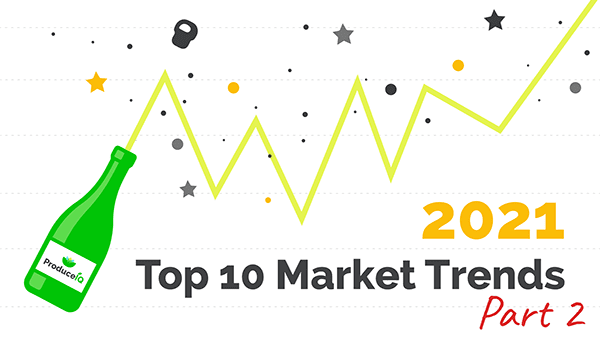ProduceIQ is bringing a bonus gift in addition to its weekly market highlights: a look to 2021, analyzing the “new normal” of 2020, and the challenges/opportunities expected to persist in in the coming months.
We’re finishing up the list of the Top 10 trends driving the produce market in today’s post. Check out yesterday’s for the first installment.
5 – Food safety & Labor
The pandemic has raised public awareness about the ‘essential worker.’ The health of frontline workers became a major concern, introducing new safety protocols to reduce the virus’ spread. Labor shortages caused by border closings highlighted the need for migrating labor forces. Growers with hand harvesting and labor-intensive packinghouses will be impacted by the passing of the $15 minimum wage laws in key produce-growing states of California, Arizona and now Florida.
4 – Bulk to CPG
Driven by fear of a spreading virus, many consumers transitioned from bulk produce to packaged produce. Uncertainty regarding the efficacy of washing produce pushed consumers to opt for bagged or boxed, over-wrapped and other methods. The increased packaging overall will heighten the need for more eco-friendly innovation.
3 – Home direct
People still need to eat, and so what replaced foodservice? 2020 began the return of the recipe, including The Covid Cookbook. What began as simply hoarding shelf-stable produce transformed into the new modern home chef. Major meal kit companies, some of whom were reporting losses in 2019, experienced high growth and began turning profits in the 2nd quarter of 2020. Further, the home-delivered produce box took off; produce distributers were forced to be creative and begin direct-to-consumer marketing.
2 – Shifting demand from Foodservice to Retail
Though quick-serve and delivery-focused restaurants have higher sales, foodservice as an industry is materially down with as many as 110,000 restaurants still closed from the pandemic. Comprising around 40 percent of the produce industry demand, a 25 percent decline in foodservice translates to a 10 percent decline in produce movement. Even if retail was able to offset this decline, the types of commodities purchased at retail are different than foodservice. In March, our industry learned just how few french fries and onion rings were prepared in the home.
1 – Government influence
Whether positive or negative, government intervention is increasing. As the country maneuvers a pandemic, balancing issues of health versus cost, many metropolitan areas continue widespread restrictions on foodservice. The SBA’s PPP, the USDA’s Farmers to Families Food Box and the federal stimulus checks attempt to offset the loss of employment and profits caused by restricting the economy.
Blue Book has teamed with ProduceIQ BB #:368175 to bring the ProduceIQ Index to its readers. The index, and weekly analysis, provides a produce industry price benchmark using 40 top commodities to provide data for decision making.



